Review| Don’t Breathe (2016)
 First thing’s first… Spoilers and sensitive subject matter ahead!
First thing’s first… Spoilers and sensitive subject matter ahead!
I can recall the first time I watched the 1967 thriller, Wait Until Dark, where a group of criminals (led by Alan Arkin) break into the apartment of a blind woman (played by Audrey Hepburn) to retrieve a doll filled with heroin brought to the apartment by her husband, unknowingly. As the criminals creep around the house and are eventually found out, the tension inherent in the games of cats and mice only build to a boil. The film is a marvel in how it plays with space and shadow. It fits into a small category of films that successfully makes tight spaces as much of a character as those that tread upon its floors.
One of the key scenes in the film finds an increasingly terrified Hepburn running through her living room in the foreground and Arkin’s malevolent presence leaping after her with feline prowess. What makes Wait Until Dark work is that it turns the tables on preconceptions about disability. Hepburn is blind and terrified during a good portion of the film, but when lights go out and the sky goes dark, those with sight are no longer in a place of power. It is the woman without sight that rules in the darkness. She knows the spaces of her apartment better and she knows the darkness much better than they do.
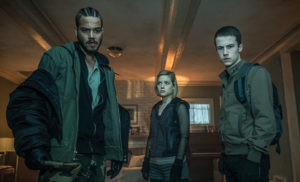 It is this film that came to mind in the lead up to Don’t Breathe’s opening weekend and the film that became a running commentary in my head as I witnessed, once again, the building terror of the chase and shattered assumptions creak and shamble along the corridors of a blind man’s secluded home. On the surface, the plots are the same: a group of thieves desire something on the inside of a residence where a blind person resides. Assuming the ease of the robbery, they find themselves on a terrain where the power dynamics shift and their strengths become their weaknesses. However, something happens in Don’t Breathe somewhere along the way. Unlike Hepburn’s innocent Susy whom the audience is rooting for from the first to the last minute of the film, Don’t Breathe’s unnamed blind man has a secret. In the basement. And he is far from innocent.
It is this film that came to mind in the lead up to Don’t Breathe’s opening weekend and the film that became a running commentary in my head as I witnessed, once again, the building terror of the chase and shattered assumptions creak and shamble along the corridors of a blind man’s secluded home. On the surface, the plots are the same: a group of thieves desire something on the inside of a residence where a blind person resides. Assuming the ease of the robbery, they find themselves on a terrain where the power dynamics shift and their strengths become their weaknesses. However, something happens in Don’t Breathe somewhere along the way. Unlike Hepburn’s innocent Susy whom the audience is rooting for from the first to the last minute of the film, Don’t Breathe’s unnamed blind man has a secret. In the basement. And he is far from innocent.
We end up rooting for the thieves by the end of the film, especially Rocky—played by Jane Levy who also played lead in Fede Alvarez’s Evil Dead remake. Rocky, along with her two friends, the foolhardy boyfriend, Money, and the sensitive, lovelorn Alex, goes into the house to find a cash settlement the blind man (played by the seething Stephen Lang) had received after the death of his daughter. However, they don’t just find the cash, but, also, the girl who accidentally killed the blind man’s daughter shackled in the basement. Pregnant.
What follows in the third act of the film finds a strange parallel between the thieves’ intrusion into the old man’s house and the old man’s intrusion upon the female body. The man wants his daughter back so he coerces her killer to give him another child and locks her up in the basement for 9 months. He uses some of the most cold, self-deceptive reasoning in how he impregnates her: he does not penetrate her, himself, but inseminates her with his own fluids. He basically states that he avoids being a rapist because he never has sexual contact with her. However, the film very clearly points out that he is more than just physically blind, because he still intrudes upon the female body without consent to achieve his own desires. He is still a rapist, but he is blind to it. Thus becoming an archetype of the disturbingly prolific male orientation towards women in this day and age.
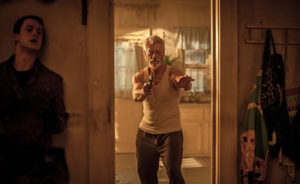 And I think it may be this very concept that elevates this film above most horror fare released in theaters. It seems as if Alvarez is creating a modern-day parable examining the blindness of male privilege and rape culture placed in the trappings of a horror/thriller narrative all about nonconsensual intrusion into spaces. It is the blind man’s logic about his right to the young woman’s body for purposes of retribution and desire fulfillment that parallel much of the male rhetoric that passes as a defense in rape and sexual abuse cases: it’s the victims fault whether it is the clothes she wears or the scorn she has shown, or any other myriad of justifications.
And I think it may be this very concept that elevates this film above most horror fare released in theaters. It seems as if Alvarez is creating a modern-day parable examining the blindness of male privilege and rape culture placed in the trappings of a horror/thriller narrative all about nonconsensual intrusion into spaces. It is the blind man’s logic about his right to the young woman’s body for purposes of retribution and desire fulfillment that parallel much of the male rhetoric that passes as a defense in rape and sexual abuse cases: it’s the victims fault whether it is the clothes she wears or the scorn she has shown, or any other myriad of justifications.
It is the terror of the situation and how it plays out that shows the absurdity of this rhetoric, which seems so prominent right now. As Carol Clover spells out in her book, Men, Women, and Chain Saws, the gender dynamics are shifted in horror when a largely male audience—though increasingly female since the writing of the book—finds themselves identifying with and rooting for a female surrogate in the place of the stereotypical male hero. Depending on one’s belief about the power of cinematic narratives to persuade their audiences, making the audience’s surrogate in the film the female Rocky and making the other male protagonists ineffective or incompetent, according to Clover, can refract the male gaze through the eyes of a woman and, on some level, force them to experience what she experiences. So in a sense Alvarez’s film becomes a type of experiment in combating bad logic and creating a space for experiencing a small portion of the threat that women feel everyday.
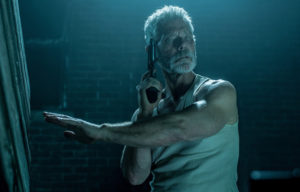 If this commentary wasn’t intense and profound enough alone, there is another layer added to it by the blind man himself. As he is about to act again, a prayer to God happens and the blind man scoffs at the prayer and implies that man does what he wants when he stops believing and ignores God. To some it might seem a little out of place within the scope of the film, but, in the tension of the moment, it felt true. It felt like the weight of the darkness of human nature—and the justifications we hide behind—and the holy goodness of God came down and scraped the concrete of that basement floor. Alvarez’s film is very steeped in a heavy sense of right and wrong; it’s just an aspect of morality that gets overlooked, it seems, by those with privilege.
If this commentary wasn’t intense and profound enough alone, there is another layer added to it by the blind man himself. As he is about to act again, a prayer to God happens and the blind man scoffs at the prayer and implies that man does what he wants when he stops believing and ignores God. To some it might seem a little out of place within the scope of the film, but, in the tension of the moment, it felt true. It felt like the weight of the darkness of human nature—and the justifications we hide behind—and the holy goodness of God came down and scraped the concrete of that basement floor. Alvarez’s film is very steeped in a heavy sense of right and wrong; it’s just an aspect of morality that gets overlooked, it seems, by those with privilege.
However, don’t expect the film to resolve in a happy ending. It doesn’t. The threat remains, just like it does for women in society today. And it is that heavy truth with which the audience leaves the darkened theater into the lit corridors. Coming out of the cave into the light, the way only a good horror film can do.


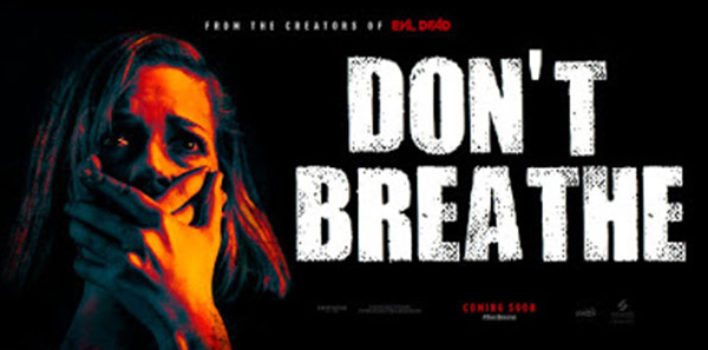
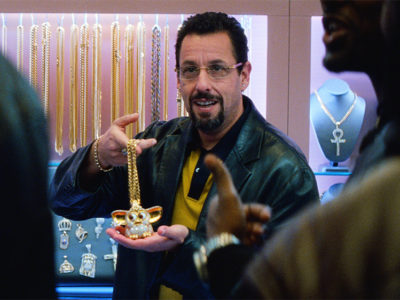
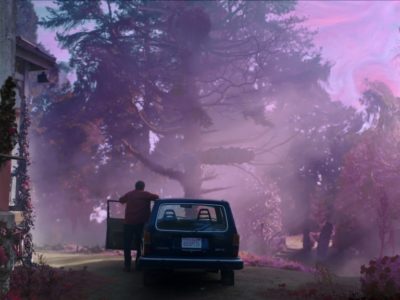



Pingback: Screaming Weekly October 2016 1.0 | Reel World Theology